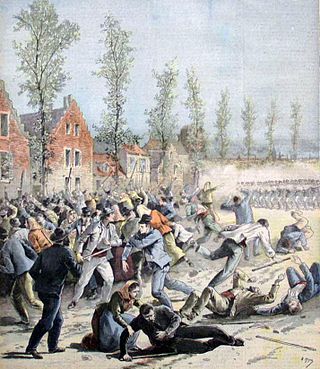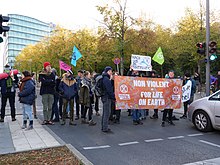
Pacifism is the opposition or resistance to war, militarism or violence. The word pacifism was coined by the French peace campaigner Émile Arnaud and adopted by other peace activists at the tenth Universal Peace Congress in Glasgow in 1901. A related term is ahimsa, which is a core philosophy in Indian religions such as Hinduism, Buddhism, and Jainism. While modern connotations are recent, having been explicated since the 19th century, ancient references abound.
Anarchism and violence have been linked together by events in anarchist history such as violent revolution, terrorism, assassination attempts and propaganda of the deed. Propaganda of the deed, or attentát, was espoused by leading anarchists in the late 19th century and was associated with a number of incidents of political violence. Anarchist thought, however, is quite diverse on the question of violence. Where some anarchists have opposed coercive means on the basis of coherence, others have supported acts of violent revolution as a path toward anarchy. Anarcho-pacifism is a school of thought within anarchism which rejects all violence.

Nonviolence is the personal practice of not causing harm to others under any condition. It may come from the belief that hurting people, animals and/or the environment is unnecessary to achieve an outcome and it may refer to a general philosophy of abstention from violence. It may be based on moral, religious or spiritual principles, or the reasons for it may be strategic or pragmatic. Failure to distinguish between the two types of nonviolent approaches can lead to distortion in the concept's meaning and effectiveness, which can subsequently result in confusion among the audience. Although both principled and pragmatic nonviolent approaches preach for nonviolence, they may have distinct motives, goals, philosophies, and techniques. However, rather than debating the best practice between the two approaches, both can indicate alternative paths for those who do not want to use violence.
Anarcho-pacifism, also referred to as anarchist pacifism and pacifist anarchism, is an anarchist school of thought that advocates for the use of peaceful, non-violent forms of resistance in the struggle for social change. Anarcho-pacifism rejects the principle of violence which is seen as a form of power and therefore as contradictory to key anarchist ideals such as the rejection of hierarchy and dominance. Many anarcho-pacifists are also Christian anarchists, who reject war and the use of violence.
Pacificism is the general term for ethical opposition to violence or war unless force is deemed necessary. Together with pacifism, it is born from the Western tradition or attitude that calls for peace. The former involves the unconditional refusal to support violence or absolute pacifism, but pacificism views the prevention of violence as its duty but recognizes the controlled use of force to achieve such objective. According to Martin Caedel, pacifism and pacificism are driven by a certain political position or ideology such as liberalism, socialism or feminism.

Steven Best is an American philosopher, writer, speaker and activist. His concerns include animal rights, species extinction, human overpopulation, ecological crisis, biotechnology, liberation politics, terrorism, mass media and culture, globalization, and capitalist domination. He is Associate Professor of Humanities and Philosophy at the University of Texas at El Paso. He has published 13 books and over 200 articles and reviews.

Christian pacifism is the theological and ethical position according to which pacifism and non-violence have both a scriptural and rational basis for Christians, and affirms that any form of violence is incompatible with the Christian faith. Christian pacifists state that Jesus himself was a pacifist who taught and practiced pacifism and that his followers must do likewise. Notable Christian pacifists include Martin Luther King Jr., Leo Tolstoy, Adin Ballou, and Ammon Hennacy.

References to climate change in popular culture have existed since the late 20th century and increased in the 21st century. Climate change, its impacts, and related human-environment interactions have been featured in nonfiction books and documentaries, but also literature, film, music, television shows and video games.

Nonviolent resistance, or nonviolent action, sometimes called civil resistance, is the practice of achieving goals such as social change through symbolic protests, civil disobedience, economic or political noncooperation, satyagraha, constructive program, or other methods, while refraining from violence and the threat of violence. This type of action highlights the desires of an individual or group that feels that something needs to change to improve the current condition of the resisting person or group.

Deep Green Resistance (DGR) is a radical environmental movement that views mainstream environmental activism as being ineffective. The group, which perceives the existence of industrial civilization itself as the greatest threat to the natural environment, strives for community organizing to build alternative food, housing, and medical institutions. The organization advocates sabotage against infrastructure, which it views as necessary tactics to achieve its goal of dismantling industrial civilization. Religious and ecological scholar Todd LeVasseur classifies it as an apocalyptic or millenarian movement.

Repertoire of contention refers, in social movement theory, to the set of various protest-related tools and actions available to a movement or related organization in a given time frame. The historian Charles Tilly, who brought the concept into common usage, also referred to the "repertoire of collective action."

Religion and peacebuilding refer to the study of religion's role in the development of peace.

Direct action is a term for economic and political behavior in which participants use agency—for example economic or physical power—to achieve their goals. The aim of direct action is to either obstruct a certain practice or to solve perceived problems.

Roy Scranton is an American writer of fiction, non-fiction, and poetry. His essays, journalism, short fiction, and reviews have appeared in The New York Times, Rolling Stone, The Nation, Dissent, LIT, Los Angeles Review of Books, and Boston Review. His first book, Learning to Die in the Anthropocene was published by City Lights. His novel War Porn was released by Soho Press in August 2016. It was called "One of the best and most disturbing war novels in years" by Sam Sacks in The Wall Street Journal. He co-edited Fire and Forget: Short Stories from the Long War. He currently teaches at the University of Notre Dame, where he is the director of the Environmental Humanities Initiative.

Andreas Malm is a Swedish author and an associate professor of human ecology at Lund University. He is on the editorial board of the academic journal Historical Materialism, and has been described as a Marxist. Naomi Klein, who quoted Malm in her book This Changes Everything, has called him "one of the most original thinkers on the subject" of climate change.

Code Rood is a network of climate activists based in the Netherlands. The activists organize large-scale civil disobedience actions in opposition to the fossil fuel industry.

Tyre Extinguishers is an international climate direct action group which deflates the tyres on sport utility vehicles (SUVs). The group describes driving an SUV as "among the worst single actions that one can take in terms of its climate impacts and its adverse effects on public safety", with SUVs having a disproportionately large impact on the climate crisis relative to other vehicles, worsening air pollution and being more likely to kill pedestrians than smaller sedan cars. The group has called for a ban on SUVs in cities, and has said that they "want to make it impossible to own a huge polluting 4x4 in the world’s urban areas".

The Fort Worth Intelligence Exchange is a fusion center housed within the Fort Worth Police Department.
Daniel Goldhaber is an American director, screenwriter, and producer. In 2018, he directed Cam, a psychological horror film set in the world of webcam pornography. In 2022, he co-wrote, directed, and produced the thriller film How to Blow Up a Pipeline, based on the book of the same name by Andreas Malm.

How to Blow Up a Pipeline is a 2022 American action-thriller film directed by Daniel Goldhaber, who co-wrote the screenplay with Ariela Barer and Jordan Sjol. It relies on ideas advanced in Andreas Malm's 2021 book of the same name, published by Verso Books. Malm's nonfiction work examines the history of social justice movements and argues for property destruction as a valid tactic in the pursuit of environmental justice. The film stars Barer, Kristine Froseth, Lukas Gage, Forrest Goodluck, Sasha Lane, Jayme Lawson, Marcus Scribner, Jake Weary, and Irene Bedard.



















